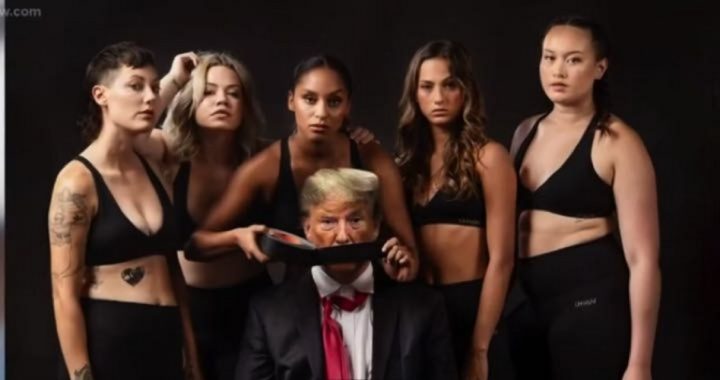
While the media are currently up in arms over President Trump using the word “lynching” — a term Democrats have uttered as well — they’re remarkably tolerant of a New York City billboard portraying violence against the commander in chief. The image, displayed in Times Square, is an advertisement by Oregon-based clothing company Dhvani that shows the president hogtied.
As Time reports, “The 30-foot-high billboard featuring a model binding a Trump look-alike with red, white and blue rope while stomping on his face, was put up last Tuesday…. Dhvani’s CEO, Avi Brown, told The Associated Press that the billboard was intended to be a comment on the Trump administration’s changes to the Title X family planning program blocking federal funding for health providers who refer patients for abortions.”
The dominatrix-like model is identified as Michal Mesa, a Marine Corps veteran and, surprise, surprise, a middle-school teacher.
There are other shocking photos as well, such as a model grabbing Trump’s cellphone while he’s sitting on a golden toilet, trousers down around his ankles; one in which a woman is putting a piece of duct tape over his mouth; and yet another where the president is on his knees being shushed by a model (video below).
Could you imagine the response if Barack Obama had been thus portrayed? Of course, it’s unlikely an advertising company would consent to display such an Obama billboard in the first place.
But CEO Brown is undeterred. “We are on the right side of history,” Time quotes him as proclaiming.
Ah, that’s a common line — among those confusing history with fashions. It’s probably more correct to say that Dhvani may be on the right side of current events. History, however, is a longer, more deliberate consideration of what has become very, very old news. And it wouldn’t be surprising if some future generation views our common prenatal infanticide the way we now view slavery. That is, until and unless history repeats itself, as it’s often cyclical.
What is for certain is that Dhvani is on the wrong side of Truth (cue the moral relativism, 3-2-1…).
But however much Brown’s clothing is in fashion, his self-righteous value-signaling certainly is. The anti-Trump images are part of his company’s “#StandForSomething campaign,” and he says he wants to give “a voice to women” (not the little women killed in the womb, though) and that he intends to donate some of the ad campaign proceeds to Planned Parenthood.
But we’ve heard such moral preening before. NBA player LeBron James sanctimoniously tweeted last year, “Injustice Anywhere Is A Threat To Justice Everywhere- Our Lives Begin To End The Day We Become Silent About Things That Matter.” But that was before opposing injustice somewhere — in Hong Kong — would have impacted upon what really matters to James: money. He’s only worth between $440-450 million, you see, and needs to find yet another pot of gold.
Ex-NBA player Charles Barkley defended James and the NBA, which also kowtows to China, by saying it was “a business decision” (yes, Chuck, so was slavery). And given that this attitude is common among the Left, one could wonder if Brown is also thus motivated.
In fact, he says that business has increased since his ad campaign. This is believable. Alienating an ideologically defined demographic would be a concern to a huge company with broad market share, such as PepsiCo; its business is so big that is has nowhere to go but down, so to speak. But few had heard of Dhvani prior to this controversy, and its market share was so small that capturing far more leftist business can only increase it. As for the conservatives alienated, most had never even known Dhvani existed.
But business concerns don’t completely explain media bias. It’s not just the earlier mentioned controversy over “lynching,” a term whose use got me put on the SPLC’s HateWatch page years ago. It’s that the media and Left in general have no principles at all concerning “violent rhetoric” — except the power principle.
Brown claims he’s not encouraging violence but is just using symbolism; that may or may not be true, and he may not even care one way or the other. But such imagery does further stoke unrest’s fires at a time in which the Left already is violent, as epitomized by Antifa, BLM, and liberals in general confronting Trump officials in public places and attacking the president’s supporters.
But while the media show blithe indifference to the Dhvani billboards — and while they tolerate continual violent anti-Trump rhetoric and imagery, as Breitbart illustrated — conservatives are held to a somewhat different standard.
It’s not only the “lynching” nonsense and that ex-Alaska governor Sarah Palin was once slammed for symbolically using cross hairs imagery. The Left also has equated MAGA hats with Klan hoods and characterized “Build that wall!” chants, opposition to the “trans” agenda, “illegal alien,” and many other terms and substantive opinions as “hate speech.” There’s method to this madness, too.
It’s all part of an effort to squelch dissent. “Consider here that powerful slogans and symbols are how you market your ideas; analogous to this, this is why businesses use jingles, slogans, and trademarks,” I explained earlier this year. “Imagine how marketing might be hobbled if McDonald’s, Geico, or Vaseline could no longer use, respectively, its golden arch; talking gecko; or, well, its name, Vaseline. What’s happening politically is that anything rhetorically effective for conservatives — anything that has influenced people or threatens to do so — is labeled hateful. It’s the neutering of effective opposition via socially enforced hate-speech prohibitions against it.”
Meanwhile, hypocritical, mercenary companies can make money with actual violent imagery. And that’s what happens when you lose the social battles.
As I’ve warned before, if you don’t control the culture, the culture ultimately ends up controlling you.



